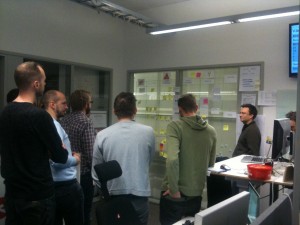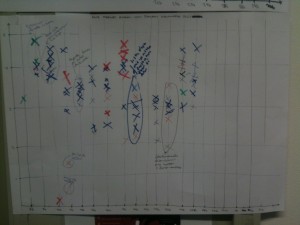Doing the same thing every day for a long time can get boring. You might even forget why you started doing it in the first place; you just keep doing the same thing, and don’t reflect on what you are getting out of it. The scrum meeting at my current client had gotten into this rut, it had devolved into a status meeting. The participants routinely answered the three questions; what I did yesterday, what I’m going to do today and what impediments I have, but they didn’t really tell each other much about what they had actually done, or what they were planning to do today. They almost never reported any impediments either.
This team has been using Scrum for almost two years. It is a very well working team from a technical perspective; they produced an even amount of user stories each sprint with a high lev el of quality. But they had lost the energy in the scrum implementation. They felt that they could do more; that they could perform even better if they just could just somehow improve their scrum implementation.
el of quality. But they had lost the energy in the scrum implementation. They felt that they could do more; that they could perform even better if they just could just somehow improve their scrum implementation.
We started working on the daily scrum meeting. Our goal was to use the meeting to give the team a good start to the day with energy and desire to start working on the tasks discussed during the meeting. In order to do this we made a few changes, both large and small in how we perform the meeting.
- The structure of the scrum board
- The process of how we perform the scrum meeting
- The location of the scrum board and the meeting
- The metric that we uses to monitor how we are improving the meeting
The structure
We changed the structure of the scrum board, to help the team make all the activities and tasks explicit and visible, and to help everyone express what they are doing. We wanted to increase the level of synchronization between the team members. The previous board only displayed the user stories, but now the team is helped by updating the wall continuously with the tasks that they will work on during he day, and tasks that they now see they will need to perform to implement a story. This creates visibility and provide concrete discussion points during the meeting.
The process
 We also changed to walk the board instead of doing a round robin answering the three questions. Since the members more routinely answered the questions we changed to go through the wall instead. Each person assigned a task describes their status and what is left to do to finalize it. Everybody working on a story can scrum on what to do to implement it as quickly as possible. This creates a more dynamic meeting, and the discussion is targeted on what to do today and in the future to implement the story, and how to collaborate in the team in order to do it quickly.
We also changed to walk the board instead of doing a round robin answering the three questions. Since the members more routinely answered the questions we changed to go through the wall instead. Each person assigned a task describes their status and what is left to do to finalize it. Everybody working on a story can scrum on what to do to implement it as quickly as possible. This creates a more dynamic meeting, and the discussion is targeted on what to do today and in the future to implement the story, and how to collaborate in the team in order to do it quickly.
The location
We changed the location of the scrum meeting and we moved away some furniture to get more space in front of the scrum board. This makes it easier for each person to access and update the scrum board during the meeting, and allows the participants to come in closer to each other and the board.
The metrics
 Finally we introduced a metric over how much energy the daily scrum gives the participants. We want to monitor how the changes that we have, and will implement, affect the team; if they succeed or fail Each participant updates the metric daily and puts his estimate of how much energy he felt on a scale of 1 to 5. 1 means that I did not get any energy at all, and 5 that I feel energized for the tasks that lei ahead during the day. The index helps us figure out why a meeting was a success or not. When the meeting gets a low or high score I ask them about it and let them discuss the reason behind it. The index and the following discussion makes the team conscious about what is creating the energy, what they are doing when they feel they get energy and value from the meeting compared to when they don’t get it.
Finally we introduced a metric over how much energy the daily scrum gives the participants. We want to monitor how the changes that we have, and will implement, affect the team; if they succeed or fail Each participant updates the metric daily and puts his estimate of how much energy he felt on a scale of 1 to 5. 1 means that I did not get any energy at all, and 5 that I feel energized for the tasks that lei ahead during the day. The index helps us figure out why a meeting was a success or not. When the meeting gets a low or high score I ask them about it and let them discuss the reason behind it. The index and the following discussion makes the team conscious about what is creating the energy, what they are doing when they feel they get energy and value from the meeting compared to when they don’t get it.
Summary
If you feel that your scrum meeting, or any other of the different meetings or practices you have in your projects have lost their purpose. If you feel that you do not get what you need from them, start experimenting by explore different ways of putting energy back into the meeting or the practice. It doesn’t matter so much which changes you make, just start experimenting; you will find your way back to creating an energizing and valuable Scrum meeting again.




Good article!
To get stuck in the same rut is quite common I would say. My current team hardly ever report any impediments either and we are looking for ways to improve this.
Did you allow the team members to suggest improvements to the process or was it only the Scrum master that tried out different ideas for imrovements?
Cheers,
Tobias, Agile Arena
Hi Tobias,
The need for improving the scrum meeting was ranked high in a retrospective and I was assigned by the team to suggest what they should change regarding the structure and process used during the meeting. After the initial change the team has continue to improve how they implement the scrum meeting, to fine tune it so that it works for them.
It is very important to help the team identify impediments, and to encourage them to express even small things that is stopping them. In general we need to train ourselves to see impediments, it is so easy to just see working conditions as it has always been before, not something that could be changed and improved. I try to get them identify at least one impediment each scrum meeting, to get them to focus on what is stopping them. I also like to put the impediment stickies on the different stories that is stopped from progress, in that way you help them to see the impediments and the need for removing them.
Hi Anders,
Thanks for this nice article. We figured out that standup meetings are great but needed improvement (they took a lot of time, de-focussed our colleagues and interrupted their workflows). Because of this we developed a SaaS tool to “automate” the daily standup meetings – with just a single email. If you like to take a look: http://www.30secondsmail.com.
Best,
Ajie